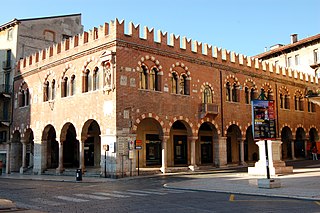
Verona is a city on the Adige River in Veneto, Italy, with 258,031 inhabitants. It is one of the seven provincial capitals of the region, and is the largest city municipality in the region and in northeastern Italy. The metropolitan area of Verona covers an area of 1,426 km2 (550.58 sq mi) and has a population of 714,310 inhabitants. It is one of the main tourist destinations in Northern Italy because of its artistic heritage and several annual fairs and shows as well as the opera season in the Arena, an ancient Roman amphitheater.
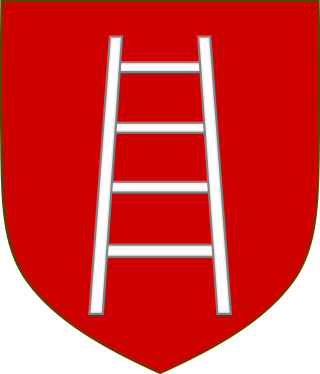
The House of Della Scala, whose members were known as Scaligeri or Scaligers, was the ruling family of Verona and mainland Veneto from 1262 to 1387, for a total of 125 years.

Cangrandedella Scala was an Italian nobleman, belonging to the della Scala family which ruled Verona from 1308 until 1387. Now perhaps best known as the leading patron of the poet Dante Alighieri, Cangrande was in his own day chiefly acclaimed as a successful warrior and autocrat. Between becoming sole ruler of Verona in 1311 and his death in 1329 he took control of several neighbouring cities, notably Vicenza, Padua and Treviso, and came to be regarded as the leader of the Ghibelline faction in northern Italy.
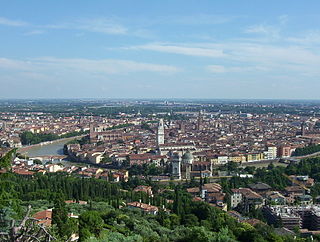
Events in the history of Verona, in Italy.
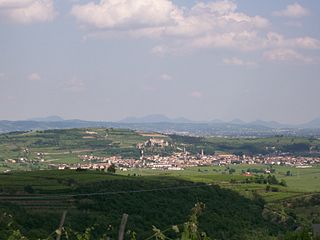
Soave is a small comune of the Veneto region in the Province of Verona, northern Italy, with a population of roughly 6,800 people.

Alberto I della Scala was lord of Verona from 1277, a member of the Scaliger family.
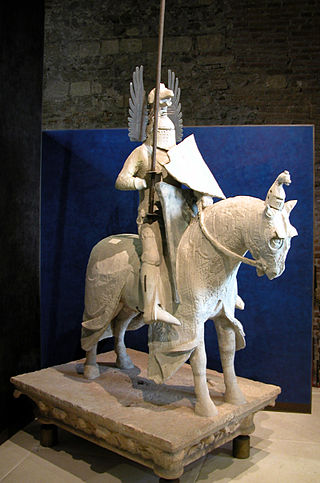
Mastino II della Scala was lord of Verona. He was a member of the famous Scaliger family of Northern Italy.

Giovanni Visconti (1290–1354) was an Italian Roman Catholic cardinal, who was co-ruler in Milan and lord of other Italian cities. He also was a military leader who fought against Florence, and used force to capture and hold other cities.

Ubertino Ida Carrara, called Novello and better known as Ubertinello, was the Lord of Padua from 1338 until his death.
Alboino I della Scala was the Scaliger Lord of Verona from 1304 until his death.

The Scaliger Tombs is a group of five Gothic funerary monuments in Verona, Italy, celebrating the Scaliger family, who ruled in Verona from the 13th to the late 14th century.
Alberto II della Scala was lord of Verona from 1329 until his death. He was a member of the famous Scaliger family of northern Italy.
The Lords of Verona ruled the city from 1260 until 19 October 1387 and for ten days in 1404. The lordship was created when Mastino I della Scala was raised to the rank of capitano del popolo from that of podestà. His descendants, the Scaliger, all Ghibellines, ruled the city and its vicinity as a hereditary seigniory for a century and a half, during which the city experienced its golden age.
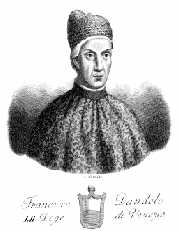
Francesco Dandolo was the 52nd Doge of Venice. He ruled from 1329 to 1339. During his reign Venice began its policy of extending its territory on the Italian mainland.
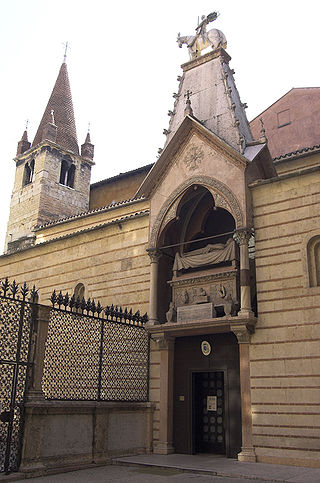
Santa Maria Antica is a Roman Catholic church in Verona, Italy. The current church is Romanesque in style and dates to 1185, rebuilt after the earthquake of 1117 destroyed the original building that dated back to the end of the period of Lombard domination in the 7th century. The only surviving remains of the 7th-century building is a fragment of black and white mosaic floor.

Marsilio da Carrara was Lord of Padua after his uncle Jacopo I. He was a member of the Carraresi family.
Jacopino della Scala, an Italian merchant and politician, was a member of the Scaliger family of future lords of Verona. He was the son of Leonardo della Scala, and also the grandson of Karafina Gambarelli and her husband Balduino della Scala, son of Arduino della Scala, who gave rise to the Della Scala dynasty
Napoleone della Torre, also known as Napo della Torre or Napo Torriani, was an Italian nobleman, who was effective Lord of Milan in the late 13th century. He was a member of the della Torre family, the father of Corrado della Torre and the brother of Raimondo della Torre.

The House of Bonacolsi was the name of an Italian noble family which ruled Mantua in the last quarter of the 13th century and the first quarter of the 14th. The Bonacolsi were the first lords of Mantua, preceding and creating the basis for the much more famous House of Gonzaga.














